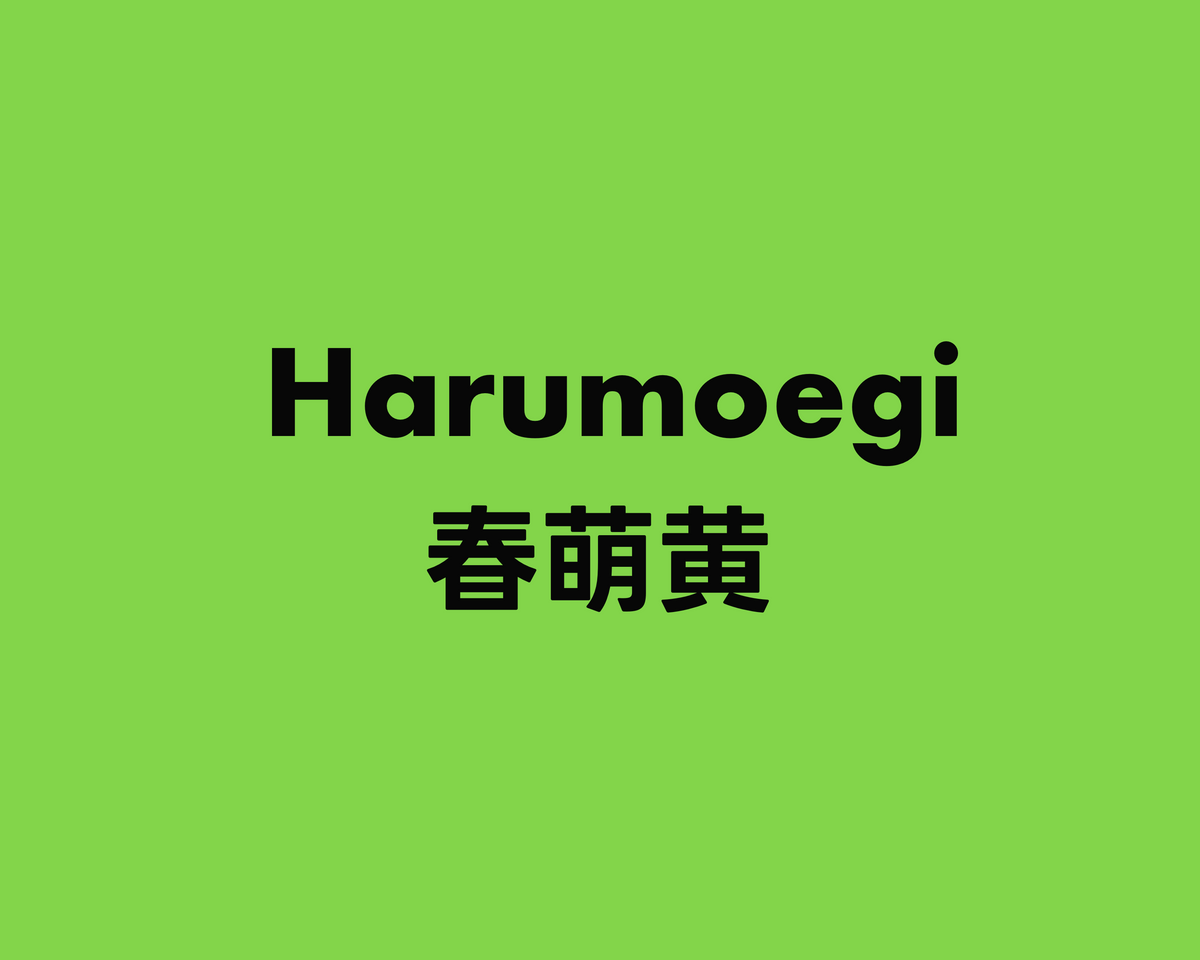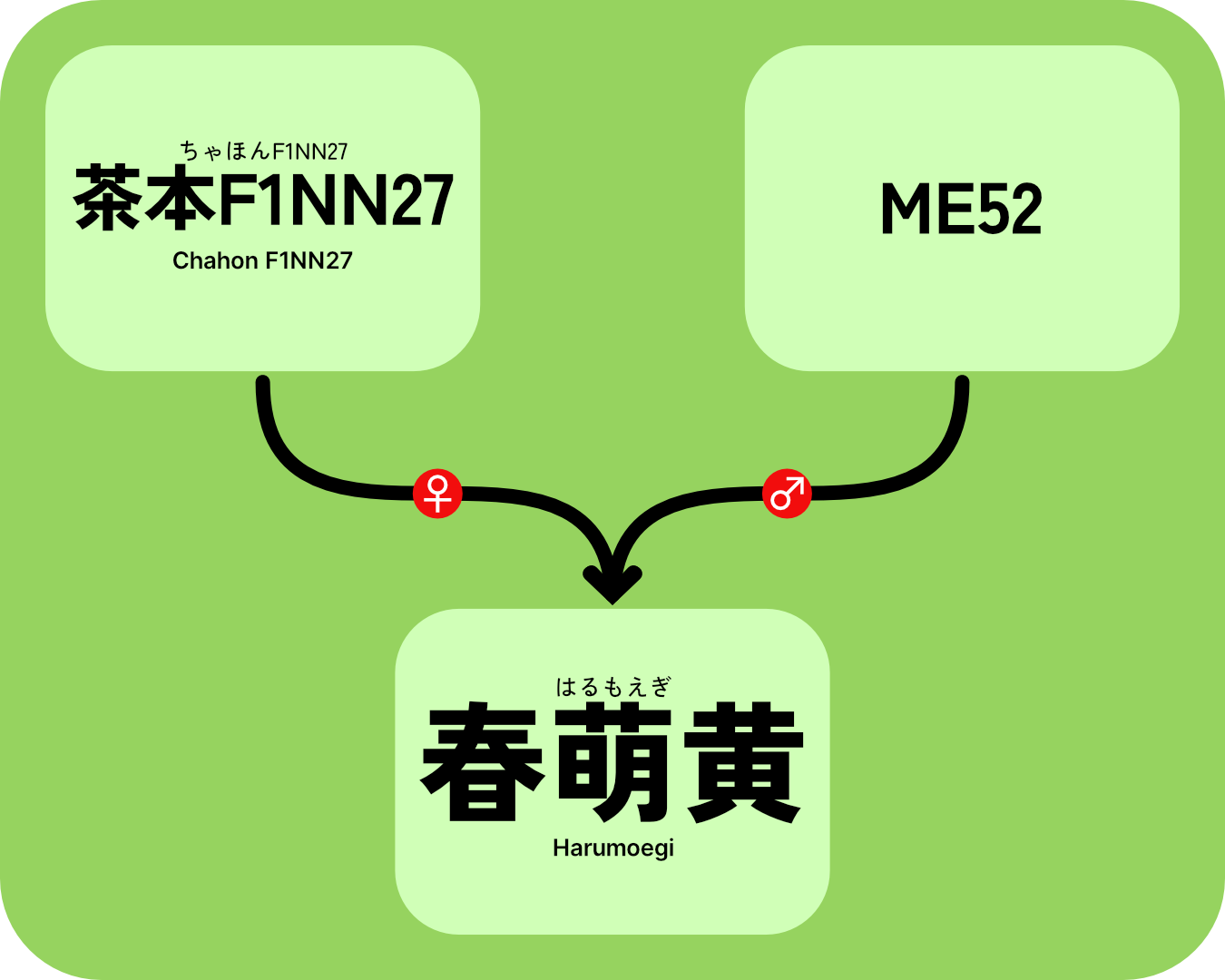Harumoegi はるもえぎ
Harumoegi (春萌黄), bred at the Miyazaki Prefectural Agricultural Experiment Station, Tea Research Branch. Crossbreed with 茶本F1NN27 as the flower and ME52 as the pollen component, this strain was selected in 1981. This strain was then further tested and compared from 1986 and then tested country-wide u

Status: 🌱
Genealogy
♀: 茶本F1NN27 (ChahonF1NN27)
♂: ME52

History
Harumoegi (春萌黄), bred at the Miyazaki Prefectural Agricultural Experiment Station, Tea Research Branch. Crossbreed with 茶本F1NN27 as the flower and ME52 as the pollen component, this strain was selected in 1981. This strain was then further tested and compared from 1986 and then tested country-wide under the name Miyazaki No.18. In 2003, it was registered in the Agriculture and Forestry Certified Cultivars under the Ministry of Agriculture, Forestry and Fisheries as number 51. Then, in 2004, the application to register the cultivar in the Seeds and Seedlings registry was filed, being registered with number 13755 in February of 2006.
This variety was selected in 1981 among almost 5000 individuals from a cross between the vigorous 茶本F1NN27 as the seed parent and the high quality, ring spot resistant ME52 as the pollen parent. In September of 1982, 4,968 seedlings were collected and planted in December of the same year in the fields for a comparative study.
From 1983 to 1985, these seedlings underwent a selection process that ended in June of 1985 with a preselection of 34 seedlings, showing excellent leaf colour and disease resistance. Cuttings from that selection were collected and propagated. In May 1986, cuttings were transplanted and grew for five years until 1990. During the nutritional tests, this particular strain was named Mi86-39.
From 1991, sustainability tests were carried out in multiple prefectures under the name Miyazaki No.18. It was tested in Shizuoka and Kagoshima individually for glutinous disease and laceration frost damage, respectively. In 1992, other prefectures joined the study for a total of 13. The study concluded in 1999 with some Kyushu 九州 prefectures like Kumamoto 熊本 and Kagoshima 鹿児島 having good yield and quality results.
In 2003, discussions at two different committees in January and March concluded with an application to the Ministry of Agriculture, Forestry and Fisheries (MAFF) to register a new cultivar name. The registration was published on the 5th of September 2003 with the name Harumoegi and registered as cultivar number 51. The name origin for 'Harumoegi', meaning spring yellow, is derived from the light green colour of the new leaves during the picking season, the absence of a reddish tone in summer tea and the fresh green colour of the product.
Characteristics
Harumoegi is a cultivar recommended for Sencha and can be grown anywhere in the country, although the southern warmer regions reported overall better results. The liquor colour is good, with mild aroma and taste. It has a lower content of tannins and a higher content of amino acids than Yabukita. Harumoegi is a medium-growing cultivar, around 1 to 2 days later budding and harvesting than Yabukita. It is an upright, slightly vigorous, moderately stout, with good rooting and early growth from cuttings. Cold resistance is good, with resistance to red blight and laceration frost damage. Harumoegi has moderate resistance to anthracnose and resistant to leaf-blight but is susceptible to mulberry scale.
Harumoegi has an upright, slightly vigorous growth habit with a small stature. The branch internode length and thickness are similar to those of Yabukita. New and adult leaves are round in shape. Medium in size and thickness. Leaves are light green and somewhat glossy, with the underside of young leaves densely covered with trichomes.
The budding of the tea leaves during the field trials was one day after Yabukita and harvest and three days after Yabukita. With this timing, it can be harvested in between Yabukita and other later budding cultivars like Kanayamidori かなやみどり.
The survival rate of the seedlings is 85%, similar to the Yabukita cultivar, and the growth rate is also the same. Once transplanted into the field, the survival rate was 86% against the 93% of Yabukita.
The average fresh leaf yield of 5 to 7-year-old bushes was 91% of Yabukita comparison on the first harvest and 110% on the second harvest. Even though the bud amount and weight were slightly higher than Yabukita, the study reveals that this could be due to the bush of Harumoegi being a more straight shape. Also, the conditions of growing in the test fields are made in single rows, so the row of Harumoegi has less surface and a smaller stub. Cultivation is recommended in two symmetric rows with low pruning to preserve the plant's growth. Half of the test sites had a lower yield than Yabukita. However, considering the cutting surface area available, the harvest yield is higher than with Yabukita. Keeping the growth and vigour of the plant to achieve stable harvest yields and a double row is recommended for that reason.
The incidence of red blight on adult leaves during the cold season is about the same as that of Yabukita, and its resistance is considered slightly high. Even in the severely cold prefectures of Ibaraki and Saitama, it has been evaluated as good as Yabukita. It is considered suitable for cultivation in both warm and temperate areas.
Frost resistance occurs earlier than Yabukita, partly because the growth of autumn buds stopped a little earlier. Frost resistance in December was higher than that of Yabukita. In addition, the resistance to bark-splitting damage due to frost was stronger than Yabukita.
Anthracnose resistance is moderate. Control measures are only required if a high incidence is expected. The incidence of red blight was slightly higher in some periods than in Yabukita, and control is also necessary when outbreaks are expected. An artificial test using live spores of Pestalotiopsis Longiseta on mature leaves showed that the disease incidence was low and the resistance was strong. The results of glutinous disease resistance tests conducted in Shizuoka Prefecture under natural conditions reported a resistance comparable to that of Yabukita, rated as slightly weak. The study shows that Harumoegi is a more resistant cultivar than Kurasawa, with many more incidences.
The spontaneous incidence of the mulberry scale was as high as that of Yabukita in the field in a year of high incidence. The results used the number of eggs as an indicator and showed that Harumoegi is as susceptible as Yabukita, which is slightly weak against it. Great attention and care should used in case of occurrence.
The quality of Sencha was slightly better than Yabukita for the first and second harvests in the several growing areas. In terms of the characteristics, the colour is particularly appreciated, the aroma is mild, and the taste is mellow.
The first harvest quality in the sustainability trials was similar to or better than that of Yabukita in five locations and slightly inferior in eight. For the second harvest, six trial locations reported similar or better quality and five trial locations reported slightly inferior quality. By region, Southern Kyushu had particularly high ratings, following the trend of better results in the southern prefectures for growth and resistance. Compared to Yabukita, the chemical composition of the aracha tea was higher in amino acid and lower in tannin. Harumoegi has thin leaves, so airflow and rotation of the machines need to be adjusted according to the harvested leaf condition.
It can be grown in tea-growing regions throughout Japan, but from the data on yield and quality in tea suitability trials, it is best grown in warmer areas. Harumoegi can be used as a cultivar between Yabukita and later cultivars like Kanayamidori. It is an upright variety with a slightly small stature, so it should be double-planted to ensure plant stature and vigorous growth for an optimal harvest yield. For disease resistance, it is susceptible to mildew and red blight disease, so great care is necessary to avoid their occurrence. Control of anthracnose under normal conditions is not required unless a high incidence is anticipated. The cultivar is available in tea nurseries with agreements with the Miyazaki Prefectural Agricultural Experiment Station, Tea Research Branch.
References
Nagatomo Hirofumi, et al. “A New Cultivar ‘Harumoegi’ for Green Tea.” Chagyo Kenkyu Hokoku (Tea Research Journal), vol. 2003, no. 96, Dec. 2003, pp. 15–26. DOI.org (Crossref), https://doi.org/10.5979/cha.2003.96_15.
https://shop.senchado.jp/collections/ocha/products/1001
http://gaityuu.com/tokuyou/tya/kuwasiro/page0001.htm
https://www.naro.go.jp/publicity_report/publication/files/cha_hinshu_handbook06.pdf
